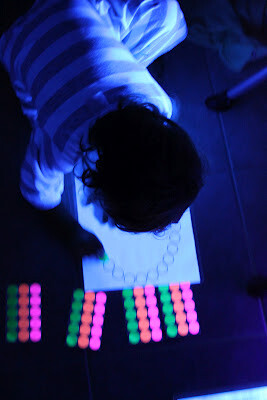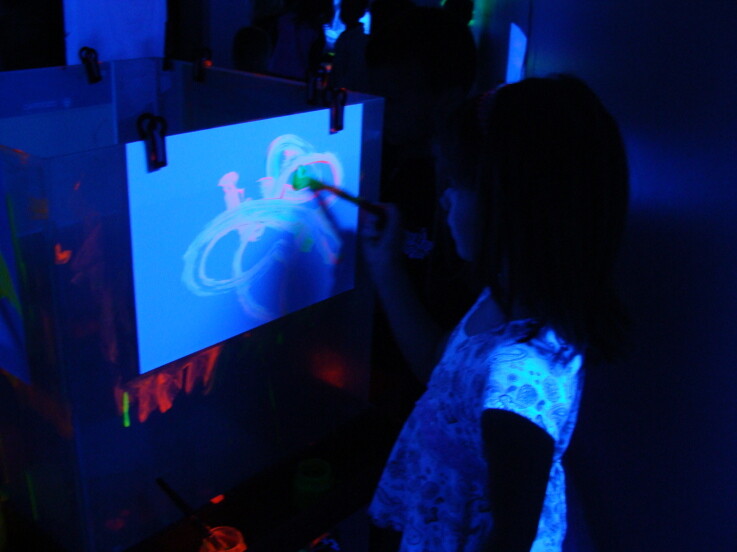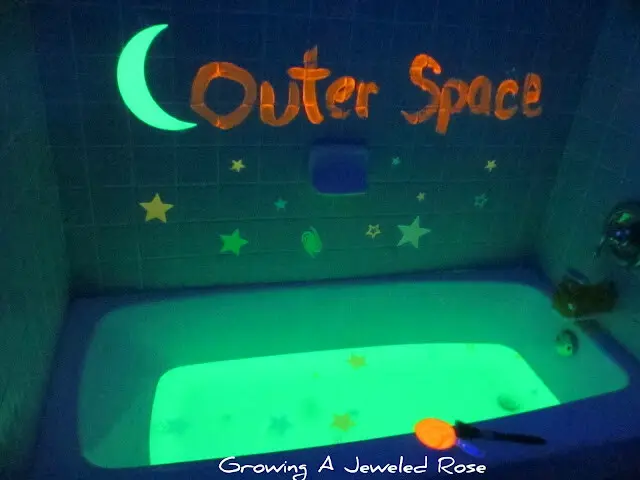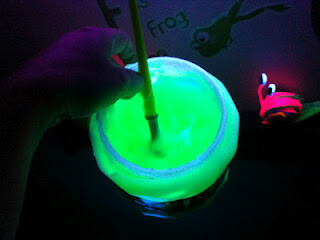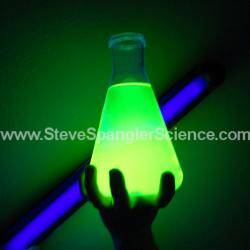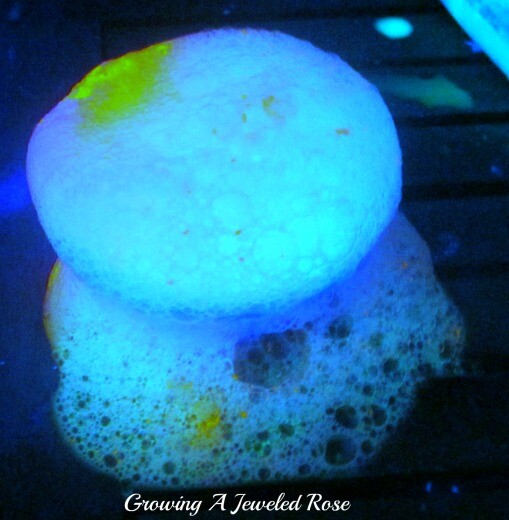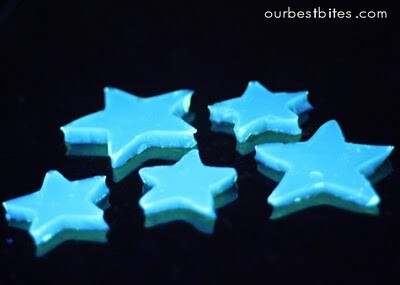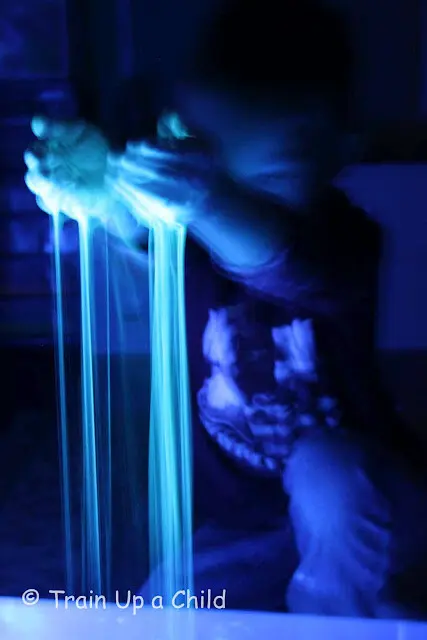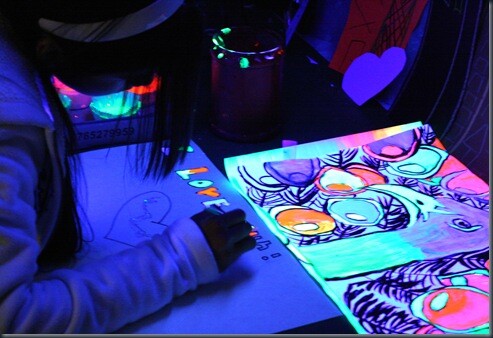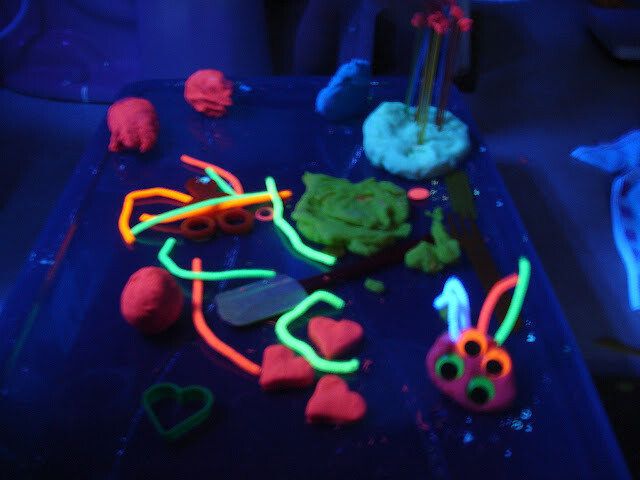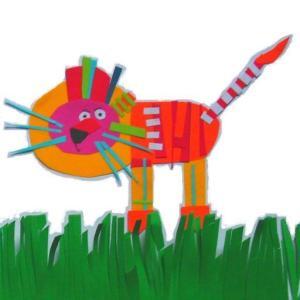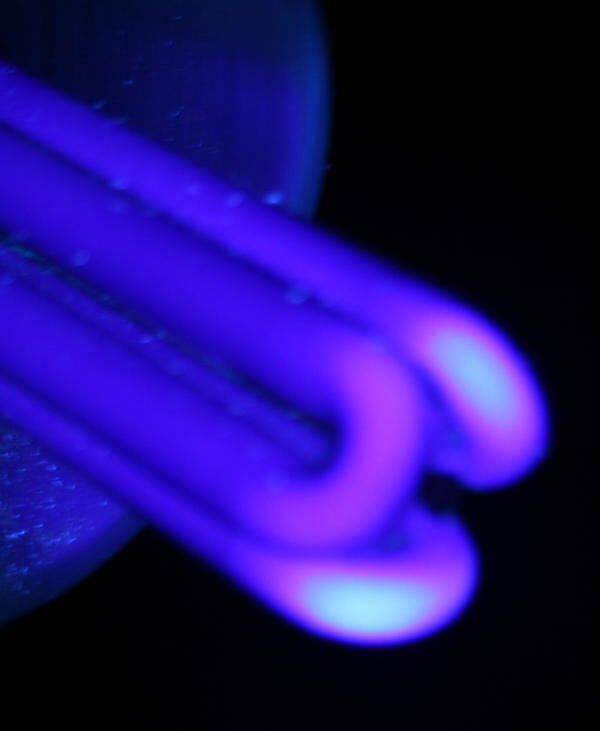
La lampada a “luce nera” per giocare con la fluorescenza. Le lampade a luce nera di cui parliamo sono in realtà lampadine BLB (Black Light Blue); somigliano alle normali lampadine fluorescenti (quelle a risparmio energetico), ma una volta accese emettono una debole luce blu-viola e rendono fluorescenti abiti bianchi, denti e vari altri elementi.
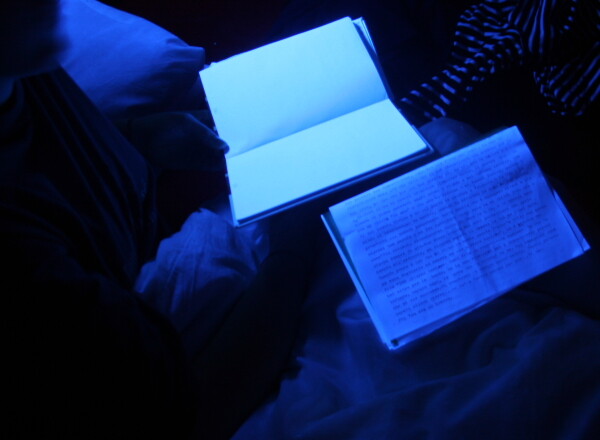
Queste lampadine a luce nera vengono utilizzate nelle feste (soprattutto Halloween, naturalmente), in locali, concerti, discoteche, parchi di divertimento per creare effetti di luce decorativi e artistici, ma anche per illuminare in modo particolare oggetti presenti nei musei, e nelle vetrine dei negozi.
Nel web imperversano meravigliose immagini di attività artistiche e scientifiche realizzate sotto luce BLB, come potete vedere scorrendo l’articolo…
Funzionano esattamente come le normali lampade a risparmio energetico: generano luce elettrica all’interno di un tubo riempito con gas inerte e una piccola quantità di mercurio; quando eccitati, gli atomi di mercurio emettono energia sotto forma di fotoni di luce.I fotoni emessi sono in parte di luce visibile, ma in parte appartengono alla gamma ultravioletta (UV).
Come sappiamo la luce UV è completamente invisibile per l’occhio umano, per questo nelle lampade a risparmio energetico viene convertita in luce visibile grazie ad un rivestimento di fosforo intorno alla parte esterna del tubo.
In una normale lampada fluorescente a risparmio energetico, la luce emessa appartiene per la maggior parte alla gamma della luce visibile: il rivestimento di fosforo le fa emettere una luce bianca che possiamo vedere, e una piccolissima parte di luce UV a onda lunga.
Le lampadine a luce nera per giocare con la fluorescenza sono a bassa potenza e si basano su questo stesso principio, ma invece del rivestimento di fosforo hanno un rivestimento scuro che blocca la maggior parte della luce visibile, e lascia passare poca luce visibile blu-viola e più luce UV ad onda lunga.
La luce UV a onda lunga emessa dalla lampadina a “luce nera” reagisce con vari fosfori presenti nell’ambiente esterno, esattamente come la luce UV all’interno di una lampada fluorescente a risparmio energetico reagisce con il rivestimento di fosforo.
Esistono tantissimi elementi naturali che contengono fosfori: i denti e le unghie, ma anche l’urina (è un trucco usato per individuare dove il gatto di casa ha fatto pipì, ad esempio).Alimenti che contengono fosfori sono la banana e l’acqua tonica (per la presenza di chinino).
Altri elementi che contengono fosforo sono: gli stick per la colla a caldo bianchi, alcuni detersivi e sbiancanti, le pagine dei libri e la carta in genere (sempre perchè in genere sbiancata), alcuni tessuti e oggetti in plastica.
Molti capi di abbigliamento bianchi sotto la “luce nera” diventano fluorescenti: la maggior parte dei detersivi per bucato, infatti, contengono fosfori che servono a rendere i bianchi più luminosi alla luce del sole (la luce del sole contiene raggi UV), e insomma quello che recitava la pubblicità “più bianco del bianco” è vero :-)Tutti gli oggetti e i prodotti fluorescenti in commercio, primi fra tutti i pennerelli evidenziatori, contengono fosforo.
Un po’ di storia e altre lampade a “luce nera”
La “lampada di Wood” (dal nome dello scienziato statunitense Robert Williams Wood) o “a luce nera” è una sorgente luminosa che emette radiazioni elettromagnetiche prevalentemente appartenenti alla gamma degli ultravioletti e, in misura trascurabile, al campo della luce visibile. La “lampada di Wood” è anche detta semplicemente “lampada UV”.
La lampada UV o lampada di Wood è largamente usata per le più svariate applicazioni. Esistono lampade UV di diversa potenza e per diversi impieghi; nei laboratori, in campo medico e non solo, sono impiegate anche lampade di Wood a onda corta (che emettono raggi che coinvogono la gamma UVB e UVC), molto pericolose, e che richiedono complesse procedure di sicurezza: gli ultravioletti di tipo B e C sono in grado di modificare il DNA umano.
Lampade UVA di comune impiego sono quelle utilizzate per la ricostruzione delle unghie, per la sterilizzazione in campo medico, o le lampade abbronzanti.
Altre lampade di Wood che sfruttano la capacità di indurre effetti di fluorescenza, oltre alle lampadine BLB, sono quelle impiegate:
– nella lotta alla falsificazione di banconote e francobolli;
– in medicina legale per l’individuazione di macchie di liquidi organici non visibili a occhio nudo;
– in medicina, per evidenziare alcune infezioni da funghi e diverse altre malattie a carico della pelle;
– in paleografia, per identificare simboli o lettere su pergamene o papiri altrimenti illeggibili a occhio nudo;
– in merceologia alimentare, per rilevare la infestazione da funghi di prodotti alimentari;
– nel restauro, per individuare la presenza di vari colori, tra i quali il verderame che, attraverso la lampada, appare diverso dalle ridipinture;
– inoltre: per il rilevamento di alcuni batteri, per effettuare test di riparazione (ispezionare il vetro, trovare perdite da tubazioni), ecc…
Sicurezza
Tornando alla nostra lampadina, le fonti consultate sostengono che le lunghezze d’onda UVA emesse sia dalla BLB, sia dalle normali lampade fluorescenti a risparmio energetico sono sostanzialmente innocue, ma come per tutte le sorgenti di luce (sia naturale, sia artificiale) il pericolo non è del tutto zero, e soprattutto coi bambini poche semplici conoscenze portano a mettere in atto le giuste precauzioni.
In rete (come potete vedere) si trovano tantissime proposte di meravigliose attività per i bambini con l’impiego di queste lampade, ma trovare le informazioni relative all’uso in sicurezza non è stato affatto facile: l’innocuità viene praticamente data per scontata.
Per contro si possono trovare anche fonti che richiamano l’attenzione su alcuni possibili rischi legati all’impiego scorretto di queste luci.
Intanto sul foglietto allegato alla mia lampadina leggo: “Questa lampada è stata progettata per uso domestico. Quando accesa, la lampada emette attorno a sè radiazioni ultraviolette. Durante la sua attività il corpo della lampada diventa molto caldo. L’unità di illuminazione deve essere dotata di protezione antischeggia. “
Queste sono le informazioni di sicurezza relative alle lampade usate per “divertimenti fluorescenti” trovate:
– intanto i danni derivanti dall’esposizione scorretta ai raggi UV (sole o luci artificiali tutte) vanno dall’ustione della pelle a danni a lungo termine agli occhi, e questo vale soprattutto per i bambini che, secondo le associazioni dei medici oculisti, in estate dovrebbero sempre indossare occhiali da sole, e possibilmente con lenti molto larghe, per giocare all’aperto. Anche l’esposizione dei bambini alla luce artificiale nelle nostre case dovrebbe seguire alcuni accorgimenti:
– nel caso delle lampadine normali a risparmio energetico, ad esempio, le lampade da scrivania dovrebbero essere sempre del tipo “incapsulato” (quelle a forma di lampadina tradizionale e non quelle col tubo visibile) perchè emettono quantità di luce UV decisamente minore. Quelle del tipo “a tubo visibile” dovrebbero essere utilizzate solo da lontano (lampadario): utilizzarle sulla scrivania o per fare qualsiasi tipo di lavoro da “vicino” comporta un’esposizione pari al trovarsi all’aperto durante una giornata di sole estiva, mentre posizionate lontano non comportano nessun pericolo. Quindi anche per illuminare le lightbox sarebbe bene utilizzare lampade del primo tipo. Sarebbe poi sempre bene limitare l’esposizione a monitor di computer e schermi tv.
– nel caso di utilizzo di lampade BLB:
1. evitarne un uso continuo e posizionare la lampada sempre ad una distanza di almeno 40 cm dalle persone;
2. schermare sempre la lampada, sia perchè va evitato (sempre!) di guardare direttamente la lampada accesa, sia perchè l’effetto ottico ne risulta anche migliorato insieme alla sicurezza. Vedrete che basta davvero pochissima intensità di luce per creare le fluorescenze, basta che la stanza sia molto buia;
3. la lampada va schermata o comunque mai tenuta a portata di bambino anche perchè diventa veramente molto calda. L’ipotesi che si rompa con piccola esplosione pare sia possibile: tenere la lampada lontana, protetta da un paralume adeguato, o schermata, è una buona pratica;
4. per illuminare soltanto un’area della casa in modo diffuso (la vasca da bagno, piuttosto che una parete o il tavolo dove si vuole giocare con la fluorescenza) posizionate la lampada il più lontano possibile e mai in modo tale che punti direttamente sulle persone (può essere semplicemente puntata verso l’alto o verso un punto della parete che non può investire il bambino direttamente) e anche per le festine effetto discoteca a tema “glow in the dark” non servirà una grande potenza, ma piuttosto che la stanza sia molto buia;
5. ripeto, non guardare mai direttamente la lampadina, e se desiderate utilizzarla in casa per creare qualche effetto artistico o scenografico particolare, puntatela sempre sulla decorazione e in modo che non cada direttamente sulle persone (alcune fonti precisano che è meglio sotto il livello della vita o dietro alle persone)
6. Un insegnante e un allievo che lavorano in una stanza buia per 2 ore sotto una luce BLB posizionata a 1 metro e mezzo di distanza, ricevono una dose di radiazioni ultraviolette pari a circa 48 secondi di sole estivo.
6. considerate, soprattutto per i bambini, l’uso di occhiali da sole con un buon filtro UVA, anche 100%. Non sono affatto costosi ed esistono modelli con elastici che li rendono davvero comodi. E’ un buon modo per familiarizzare con questo accessorio, per sentirsi ancora più “scienziati” e per imparare ad usarli sempre all’aperto, nelle giornate estive.
Conclusioni
Si tratta sicuramente di esperienze entusiasmanti per i bambini, nelle quali possono esercitare tutte le proprie capacità immaginative, provare stupore e meraviglia, sviluppare il senso per la ricerca di quanta bellezza a volte non è percepita attraverso i sensi comuni, indagare scientificamente fenomeni, mettere in atto strategie decisionali, vedere oggetti comuni trasformati in oggetti del tutto diversi, ecc…I bambini più grandi, poi, possono realizzare video e raccolte fotografiche strabilianti, scoprendo varie proprietà della luce ed utilizzandole per raccontare se stessi ed esprimere i propri sentimenti.
Per contro non si tratta di materiali “naturali” e anche se ormai di uso comune (dalle discoteche alle feste, ecc…) e molto presenti nel web, bisogna sicuramente tenere in considerazioni anche le voci che richiamano ad un uso consapevole, misurato e responsabile di questo genere di offerte, anche se esistono fonti che ne proclamano l’assoluta innocuità.Siamo in estate, e vale anche per il “naturale”: a quanti bambini vedete indossare occhialini da sole o cappelli con visiera anti UV?
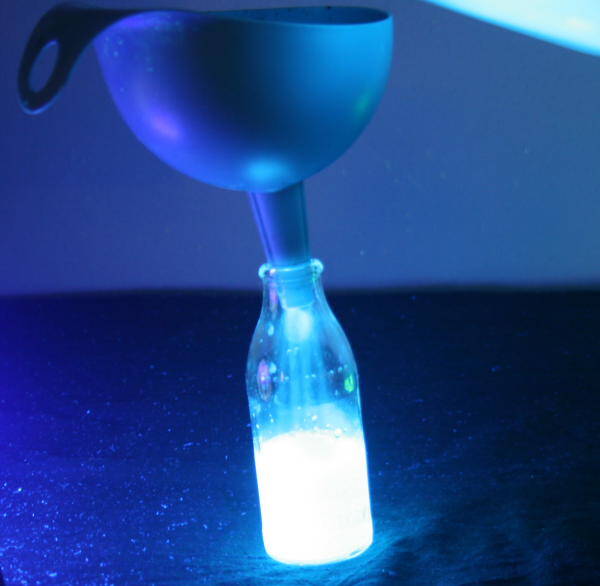
Dove si trovano
Le lampadine BLB si possono trovare abbastanza facilmente nei negozi di hobbistica, di articoli per la pesca, e soprattutto nei negozi specializzati in feste e musica. Nel web sono offerte da vari siti, oltre che su ebay. Costano circa 10 euro.
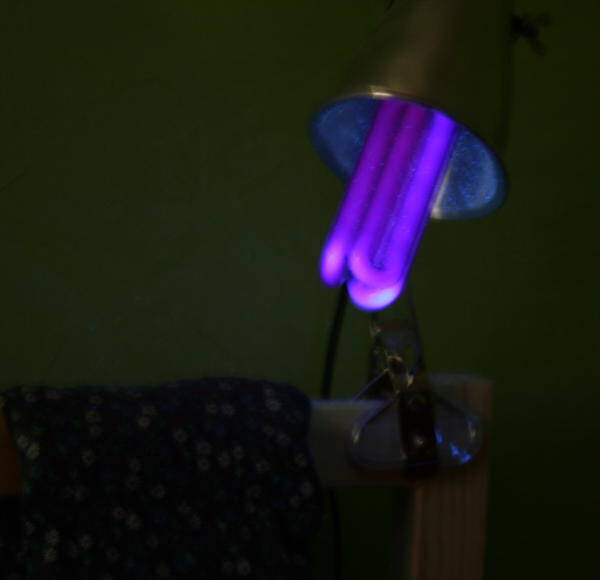
Galleria di scatti “venuti male”
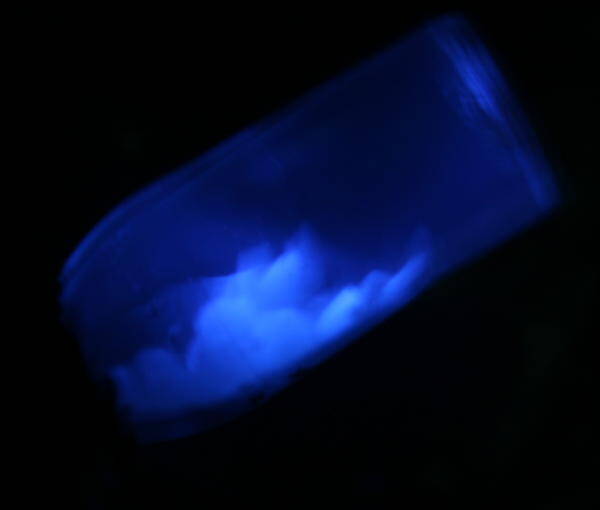
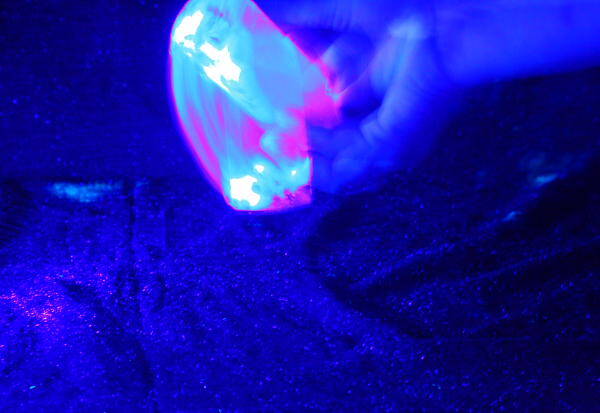
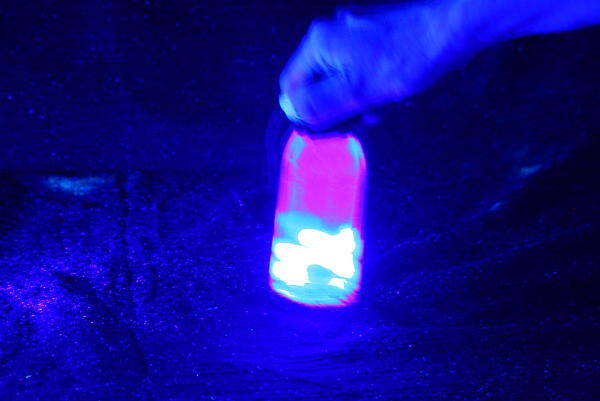
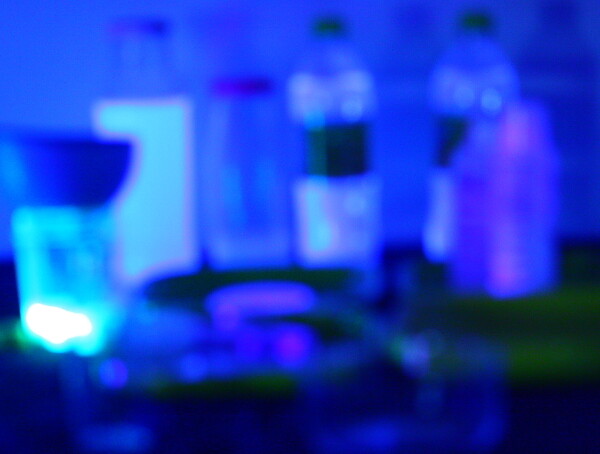
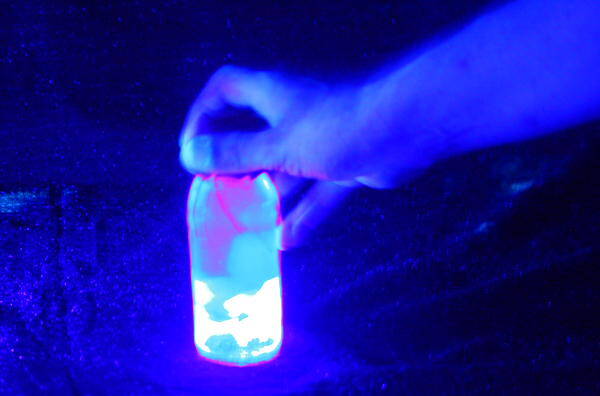
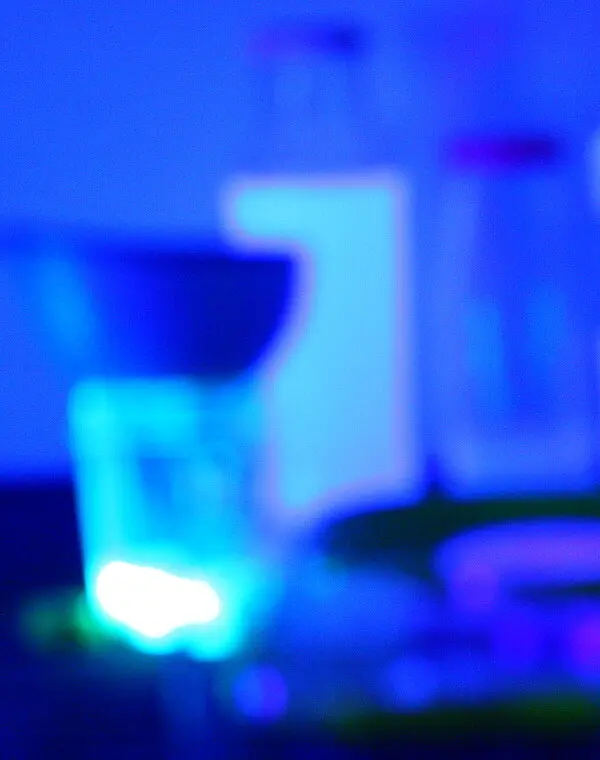
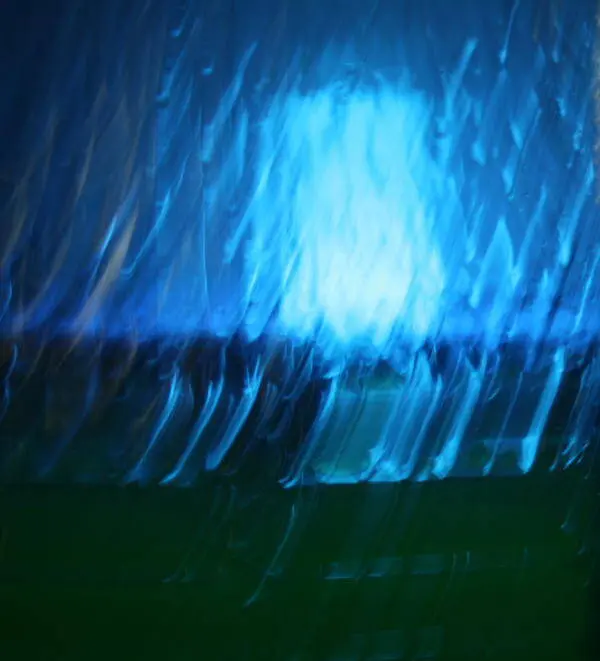
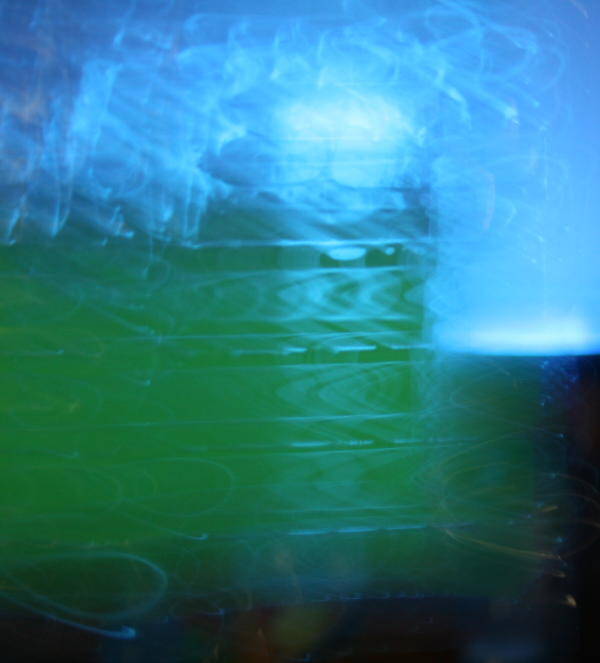
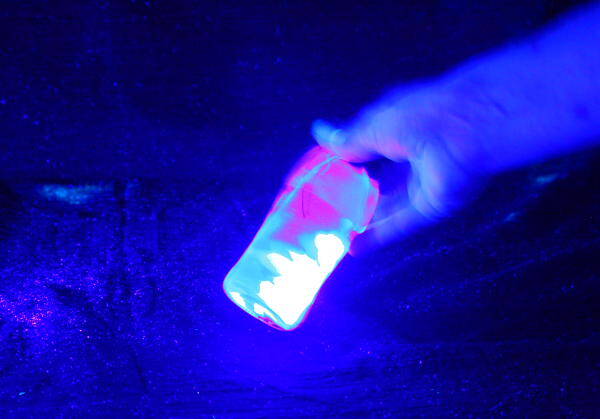
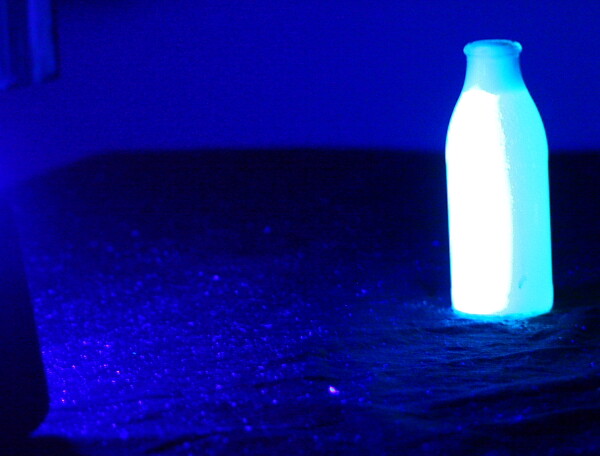
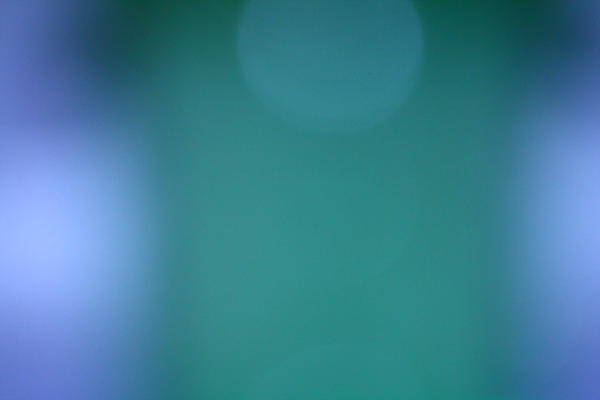
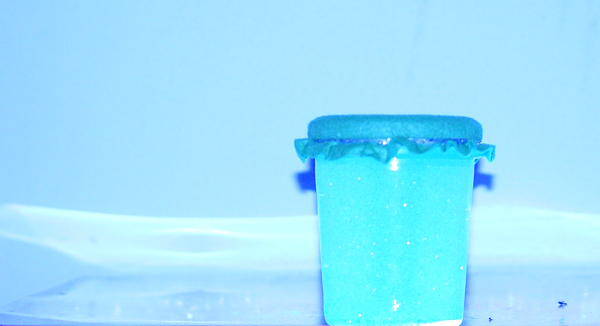
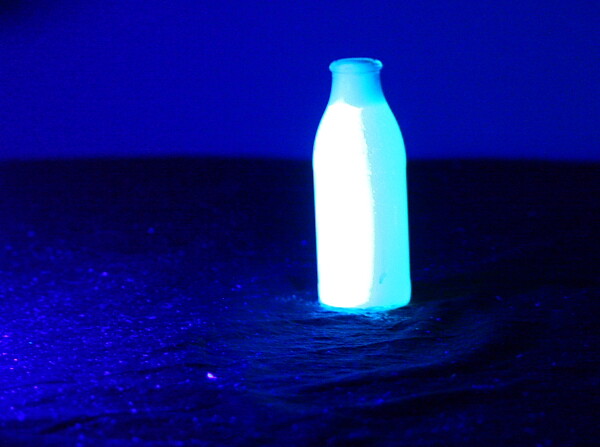
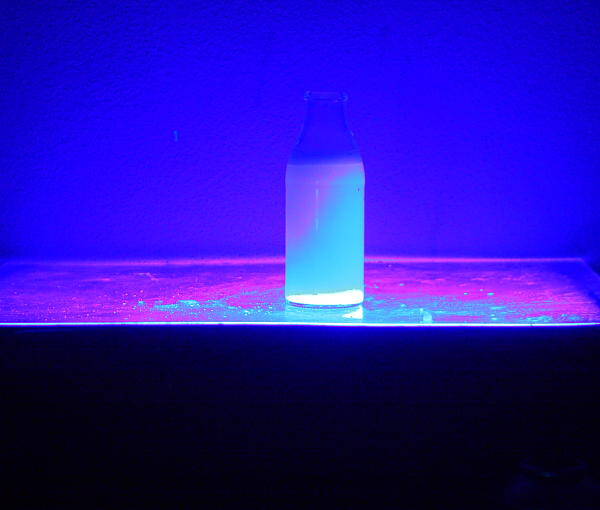
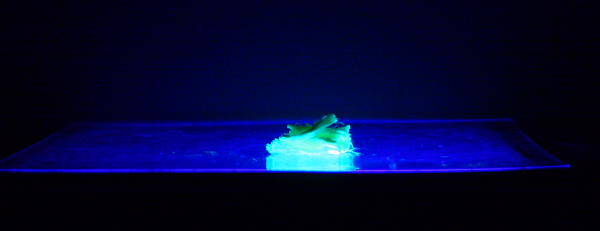
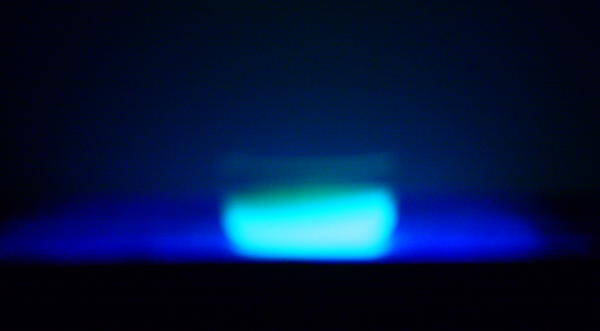
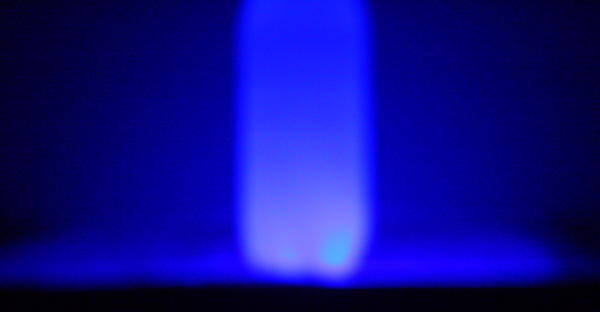
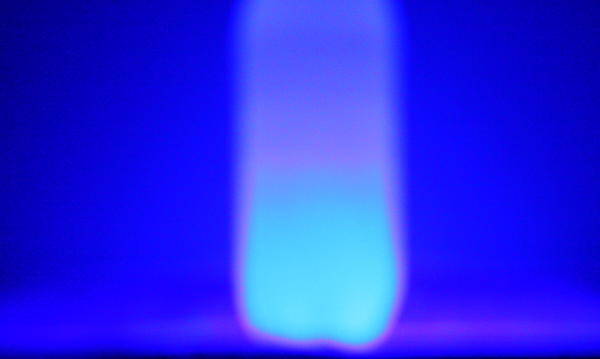
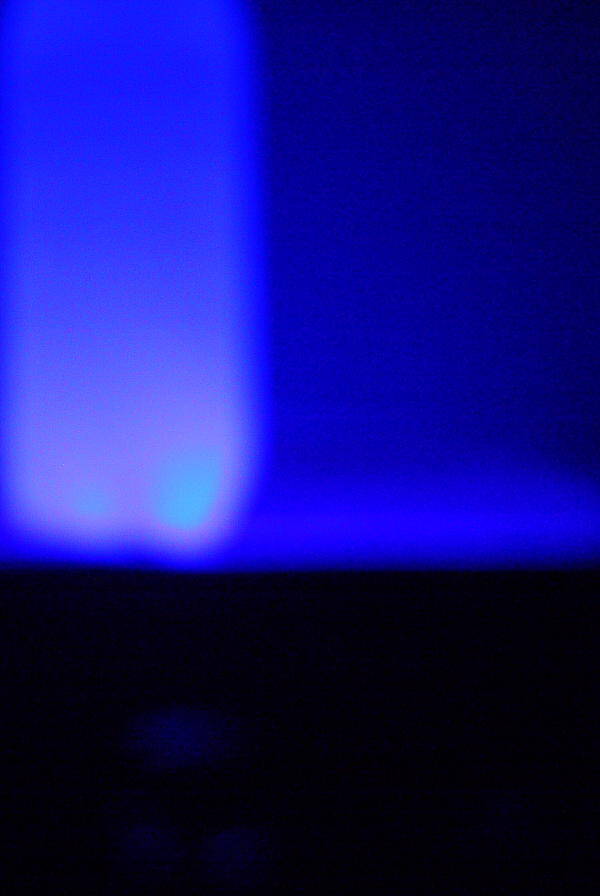
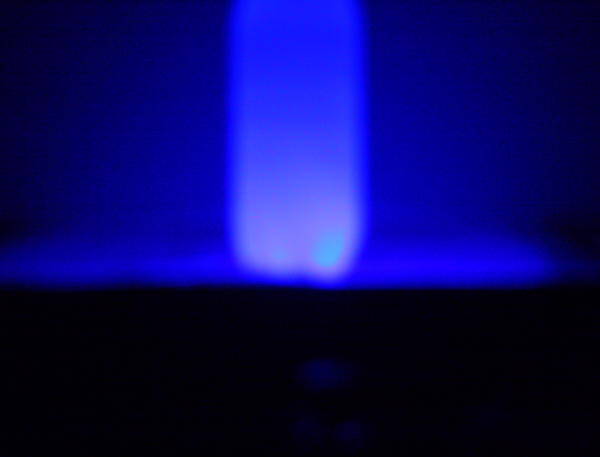
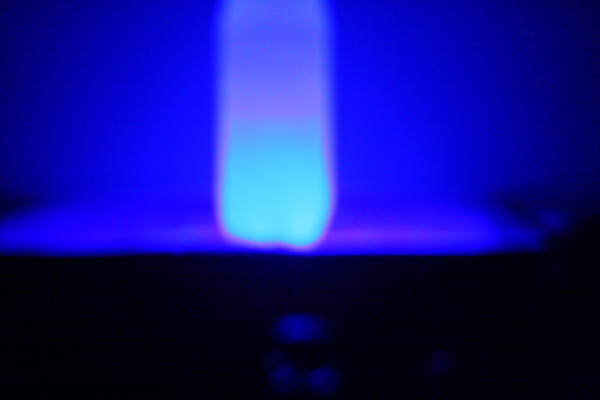
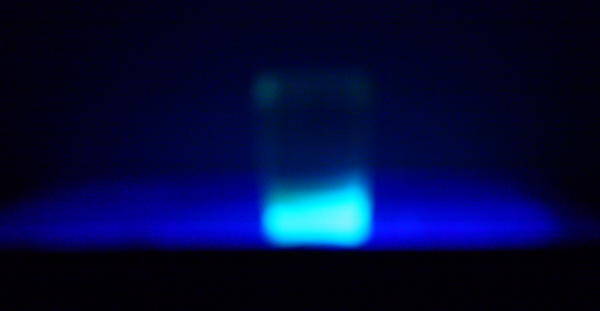
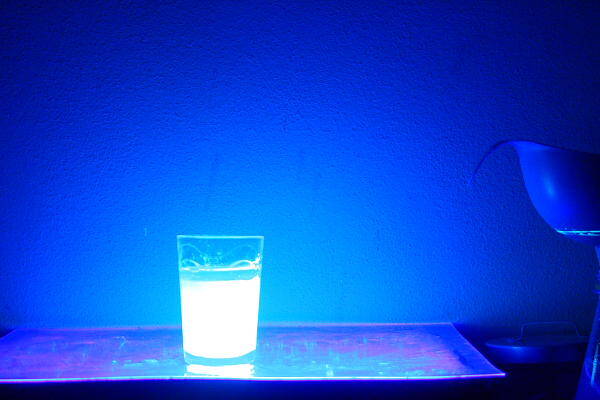
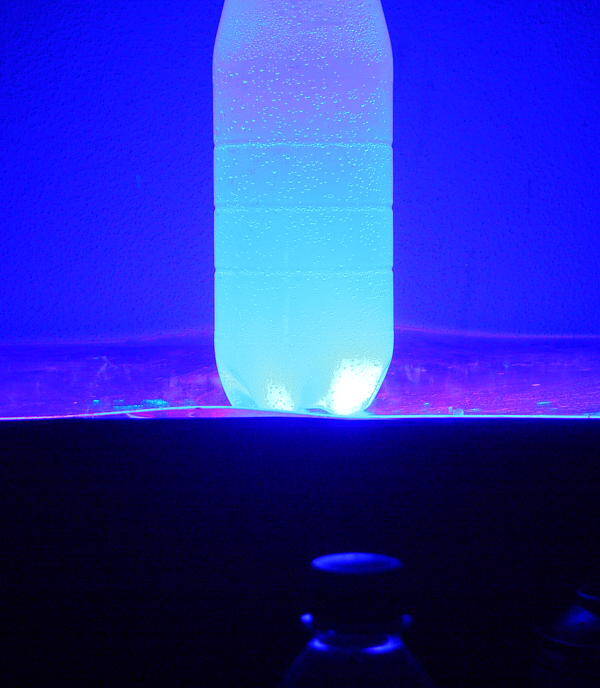
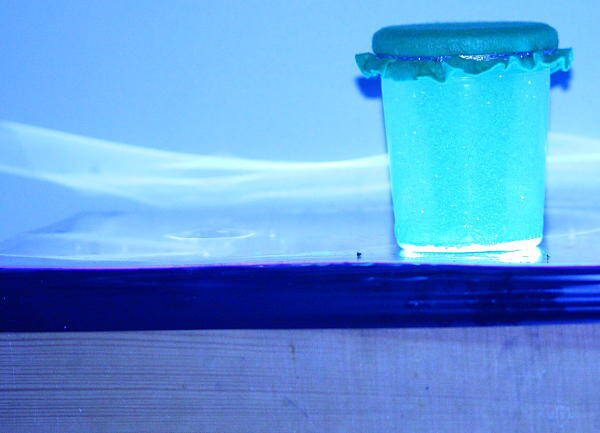
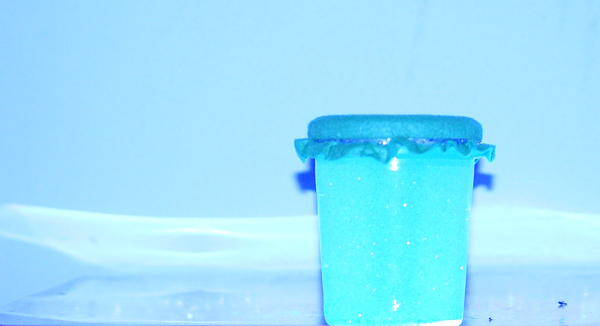
Per approfondire:
http://www.sciencekidsathome.com/science_topics/sunlight_a.html
http://science.howstuffworks.com/innovation/everyday-innovations/black-light.htm
http://www.tsbvi.edu/seehear/fall99/ultraviolet.htm
http://www.houseofonika.com/2008_10_01_archive.html
http://www.funsci.com/fun3_it/sini/eo/o11-fluor.pdf
http://www.cclvi.org/contributions/effects1.htm
http://www.portaleagentifisici.it/fo_ro_artificiali_index.php
http://www.usa.lighting.philips.com/pwc_li/us_en/connect/tools_literature/downloads/s06-93006.pdf
http://notturni.zenfolio.com/articolo–il-cielo-in-una-stanza


The “black light” lamp to play with the fluorescence. The black light lamps of which we speak are actually bulbs BLB (Black Light Blue); resemble normal fluorescent bulbs (energy-saving ones), but once lit emit a faint blue-violet light and make fluorescent white clothes, teeth and various other items.

These black light bulbs are used in parties (especially Halloween, of course), nightclubs, concerts, discos, amusement parks, to create decorative and artistic lighting effects, but also to illuminate in a particular way objects in museums, and in shop windows. Web raging wonderful images of artistic and scientific activities made under BLB light, as you can see by scrolling through the post …
They work exactly like normal energy saving lamps: generate electricity inside a tube filled with inert gas and a small amount of mercury; when excited, the mercury atoms emit energy in the form of photons of light. The emitted photons are in part visible light, but partly belong to the ultraviolet range (UV). As we know the UV light is completely invisible to the human eye, for this in the energy saving lamps it is converted into visible light through a phosphor coating around the outside of the tube. In a normal fluorescent lamp energy saving, the light emitted belongs for the most part to the range of visible light: the phosphor coating makes them emit a white light that we can see, and a very small part of UV light at long wavelengths.
The black light bulbs to play with the fluorescence are low-power and based on this same principle, but instead of the phosphor coating have a dark coating that blocks most visible light, and let little visible light blue-purple and more long-wave UV light. The long wave UV light emitted from the black light bulb reacts with various phosphors present in the external environment, exactly as the UV light inside a fluorescent lamp energy saving reacts with the phosphor coating.
There are many natural elements that contain phosphors: teeth and nails, but also urine (a trick used to identify where the house cat has urinated, for example). Food containing phosphors are the banana and tonic water (for the presence of quinine). Other items that contain phosphorus are: sticks for hot glue white, some detergents and bleaches, the pages of books and paper in general (again because usually bleached), some tissues and plastic objects. Many clothing whites under the “black light” become fluorescent: most laundry detergents, in fact, contain phosphors that serve to make the whites brighter in sunlight (sunlight contains UV).
All objects and fluorescent products on the market, first of all the markers highlighters, contain phosphorus.
The “black light” lamp to play with the fluorescence
A bit of history and other “black light” lamps.
The “Wood lamp” (from the name of US scientist Robert Williams Wood) or “black light” is a light source that emits electromagnetic radiation almost belonging to the ultraviolet range and, to a negligible extent, to range of visible light. The “Wood lamp” is also referred to simply as “UV lamp”.
The UV lamp or Wood lamp is widely used for the most varied applications. There are UV lamps of different power and for different uses; in laboratories, in the medical field and not only, they are also used Wood lamps shortwave (emitting rays involving the range UVB and UVC), much dangerous, and that require complex security procedures: ultraviolet type B and C are able to modify the human DNA.
UVA lamps commonly used are those used for the reconstruction of the nails, for the sterilization in the medical field, or the tanning lamps.
Other Wood lamps that exploit the ability to induce fluorescence effects, in addition to the BLB bulbs, are those used:
– In the fight against counterfeiting of banknotes and stamps;
– In forensic medicine for the detection of spots of organic liquids that are not visible to the naked eye;
– In medicine, to highlight some fungal infections and many other diseases of the skin;
– In paleography, to identify symbols or letters on parchment or papyrus otherwise illegible to the naked eye;
– In the food product sector, to detect the infestation by fungi of food products;
– In the restoration, to detect the presence of various colors, such as verdigris that, through the lamp, it looks different from repainting;
– Also for the detection of certain bacteria, to carry out repair test (inspect the glass, find leaks in pipes), etc …
The “black light” lamp to play with the fluorescence
Security
Returning to our bulb, the sources consulted say the wavelength UVA issued either by the BLB, both from normal energy-saving fluorescent lamps are basically harmless, but as with all light sources (both natural and artificial), the danger is not completely zero, and especially with kids a few simple knowledge lead to put in place the right precautions.
On the web (as you can see) are many proposals of wonderful activities for children with the use of these lamps, but finding information about the safe use was not at all easy: the safety is virtually taken for granted.
By contrast you can also find sources that draw your attention to some possible risks linked to the use improper of these lights.
First, on the enclosed leaflet to my bulb I read: “This lamp is designed for domestic use. When lit, the lamp emits ultraviolet radiation around itself. During his activity the lamp body becomes very hot. The lighting unit must be cover with shatter protection. “
This is the information security relating to lamps used for “fluorescent entertainment ” found:
– Damage resulting from exposure incorrect to UV rays (sunlight or artificial light all) go from the skin burns to long-term damage in the eyes, and this is especially true for children who, according to the associations of ophthalmologists, in the summer should always wear sunglasses, and possibly with much large lenses, to play outdoors. Even children’s exposure to artificial light in our homes should follow some precautions:
– In the case of normal energy-saving light bulbs, for example, desk lamps should always be of the type “encapsulated” (those to the form of standard bulb and not those with the tube visible) because they emit amount of UV light much lower. Those of the type “tube visible” should only be used from a distance (chandeliers): use them on your desk or to make any kind of work by “near” entails exposure equal to be outdoors during a sunny day summer while positioned far pose no danger. So also to illuminate the lightbox it would be good to use lamps of the first type. It would then always good to limit exposure to computer monitors and TV screens.
– In the case of use of BLB lamps:
1. avoid continuous use and always place the lamp at a distance of at least 40 cm from all persons;
2. always shield the lamp, and because it should be avoided (always!) to look directly at the lighted lamp, and because the optical effect resulting also improved along with safety. You will see that just really very little intensity of light to create the fluorescence, It serves only that the room is very dark;
3. The lamp goes screen or otherwise never held at child height also because it gets really hot. The hypothesis that breaks with small explosion seems possible: hold the lamp distant, protected by an appropriate lampshade or screen, it is a good practice;
4. to illuminate only an area of the house diffusely (the bathtub, rather than a wall or table where you want to play with the fluorescence) place the lamp as far as possible and never in such a way that points directly on the people (may be simply pointing upward or to a point on the wall that can not invest the child directly) and also for parties effect disco themed “glow in the dark” does not need a great power, but rather that the room is very dark;
5. I repeat, do not look directly into the light bulb, and if you want to use it at home to create some artistic or dramatic special effect, direct it more on decorating and so it does not fall directly on the people (some sources state that it is better under the waist level or behind people)
6. A teacher and a student that work in a dark room for two hours under a light BLB positioned at 1 meter and a half away, they receive a dose of ultraviolet radiation equal to about 48 seconds of summer sun.
7. consider, especially for children, the use of sunglasses with good UV filter, even 100%. They are not at all expensive, and there are models with elastic bands that make them really comfortable. It is a good way to familiarize with this accessory, to feel even more “scientists” and to learn to use them always outdoor, in the summer days.
The “black light” lamp to play with the fluorescence
Conclusions
They are definitely exciting experiences for children, where they can exercise all their imaginative abilities, feel amazement and wonder, develop a sense for finding how much beauty is sometimes not perceived through the senses common, investigate scientific phenomena, implement strategic direction, see everyday objects transformed into objects completely different, etc … The older children, then, can make videos and photo collections astonishing, revealing various properties of light and using them to tell themselves and express their feelings.
On the other hand it is not “natural” materials and although now in common use (from discotheques to parties, etc …) and much present on the web, you need to definitely take into consideration the voices that call for a conscious use, measured and responsible for this kind of offers, although there are sources that claim to be completely safe. We are in the summer, and also applies to the “natural”: how many children wear sunglasses or hats with visor UV protection?

The “black light” lamp to play with the fluorescence
Where can they find?
BLB bulbs can be found quite easily in hobby shops, shops for fishing, and especially in specialty stores in parties and music. On the web are offered by various sites, as well as on ebay. It costs about $ 10.

The “black light” lamp to play with the fluorescence
Gallery of shots “come wrong”


























The “black light” lamp to play with the fluorescence
Other links
http://www.sciencekidsathome.com/science_topics/sunlight_a.html
http://science.howstuffworks.com/innovation/everyday-innovations/black-light.htm
http://www.tsbvi.edu/seehear/fall99/ultraviolet.htm
http://www.houseofonika.com/2008_10_01_archive.html
http://www.cclvi.org/contributions/effects1.htm
http://www.usa.lighting.philips.com/pwc_li/us_en/connect/tools_literature/downloads/s06-93006.pdf

